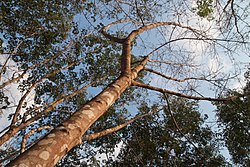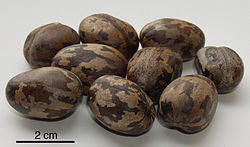Para rubber tree
A Para rubber tree (or simply, rubber tree) is the tree which naturally produces rubber. It is native to tropical areas from South America, in the Amazon (Brazil), but was spread by European farmers to the Far East.
| Para rubber tree | |
|---|---|

| |
| Scientific classification | |
| Unrecognized taxon (fix): | Heveinae |
| Genus: | Hevea |
| Species: | H. brasiliensis
|
| Binomial name | |
| Hevea brasiliensis | |
Para Rubber trees belong to the Euphorbiaceae family. In the wild they may reach heights of 100 to 125 ft (30-38 m) with large cylindrical trunks with or without buttresses. Crop trees reach a width of about 20 in. (50 cm), usually with a short bole, and with a sloped taper.
Most rubber plantations are in South Asia and Southeast Asia. When trees reach 5-6 years old, they are harvested. Their trunks are cut just deep enough to tap the vessels without harming the tree's growth, and the sap is collected in small buckets. This process is known as rubber tapping. Older trees produce more latex, but they stop producing it after 30-40 years. It was first collected in para district of brazil. Sri henry Wickham brought the seeds of para rubber from Brazil to India and Sri Lanka through the kew botanical garden in 1876. At first, the plantation was done in Malayasia and Sri Lanka and later in Java, Sumatra, India and parts of Indonesia.
Para Rubber Tree Media
A sprouting seed in a house backyard in Malaysia







